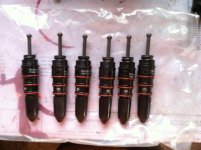Over the weekend we tried a third way to set up the overhead, mainly the injectors. This time we put a dial indicator on the injector side of the rocker arm to measure the injector travel. Previously the injectors were set to 70 in-lb (the torque spec we got from a Cummins Shop Manual).
We ran through the cycle one time to measure the full travel of the injector. We found where the cam follower would have been resting on the cam shaft and then found where the cam follower would have been at the highest point on the cam lobe. Five of the injectors traveled about 0.185", one injector only traveled 0.146".
For the injector that had a shorter travel I had hopes of tightening the adjuster to allow for close to 0.185" of travel. My hopes and dreams were crushed pretty quick. I was only able to achieve about 0.010" more travel before the adjuster bottomed out and had no more adjustment.
Needless to say I put it all back together and made, what I thought, was some improvement. The engine starts up right off the bat, doesn't even roll over one time and it comes to life. Still a little white smoke at an idle, but not terrible, not as bad as it was. My father thinks it has a skip, he is thinking cylinder 4 or 5 but our bad cylinder was cylinder 3. I don't hear a skip but maybe its my virgin ears, and I can't detect that yet.
Next step is to get it all put together and go drive it. We think that maybe a key factor in all off this. Since we have owned the truck, it has not been up to operating temperature. And it may just need to get some cob webs worked out after sitting for at least 7 years.
Here is another video for anyone who is interested.
IMG_1817_zps50ef8bb4.mp4 Video by RockinRam96 | Photobucket


